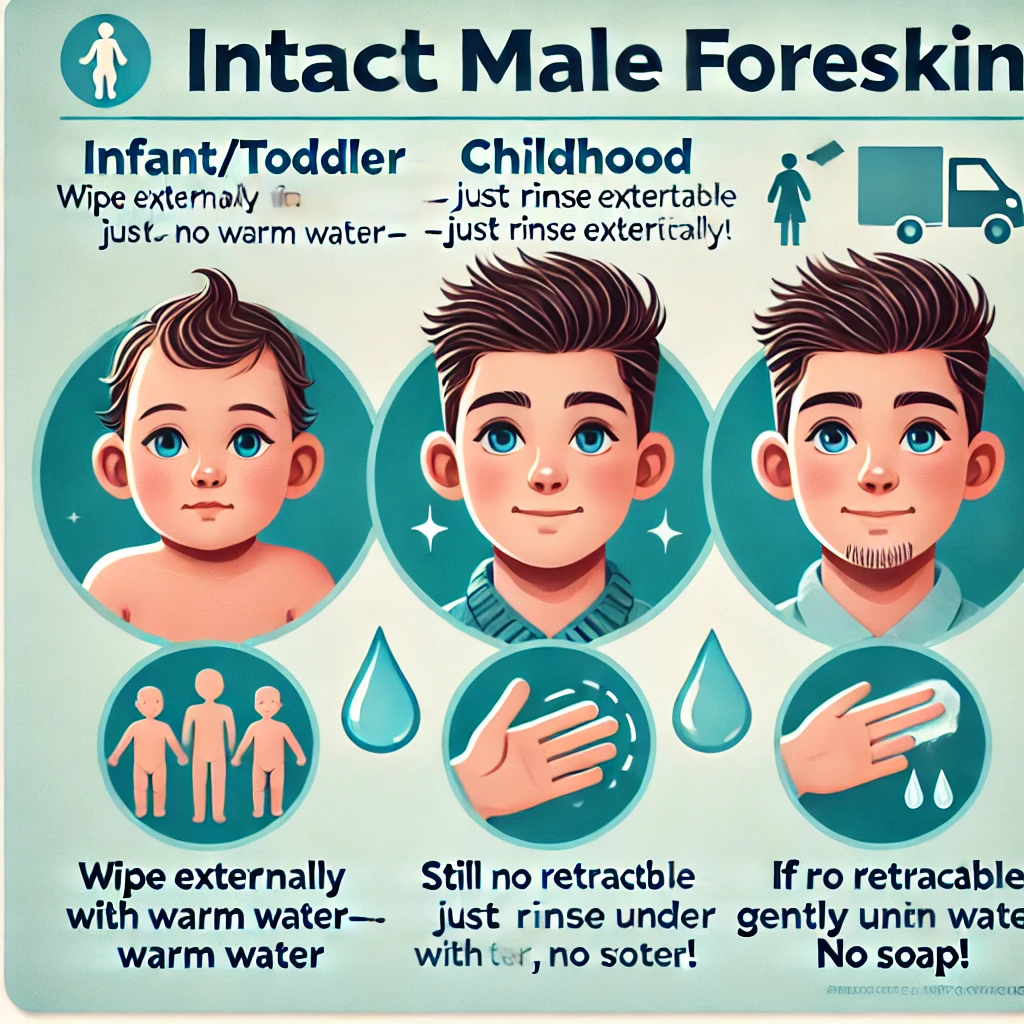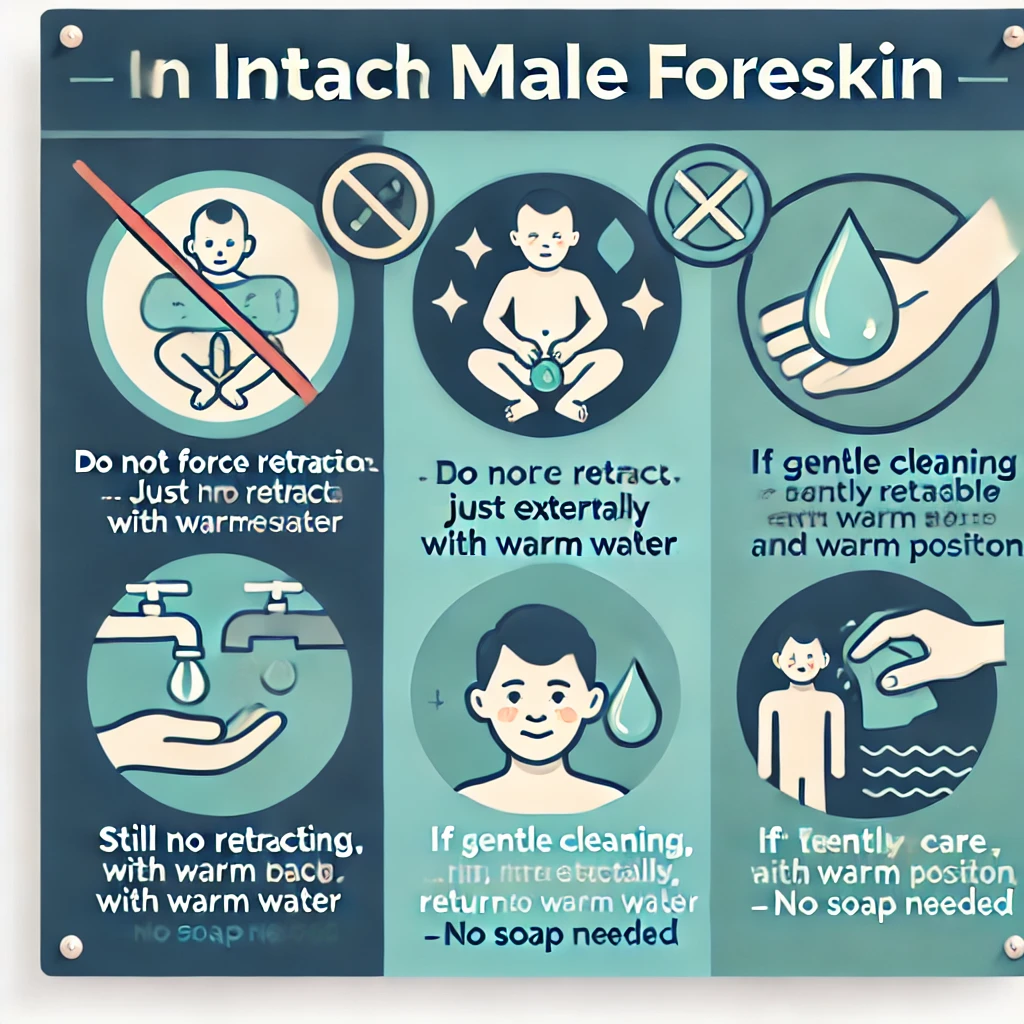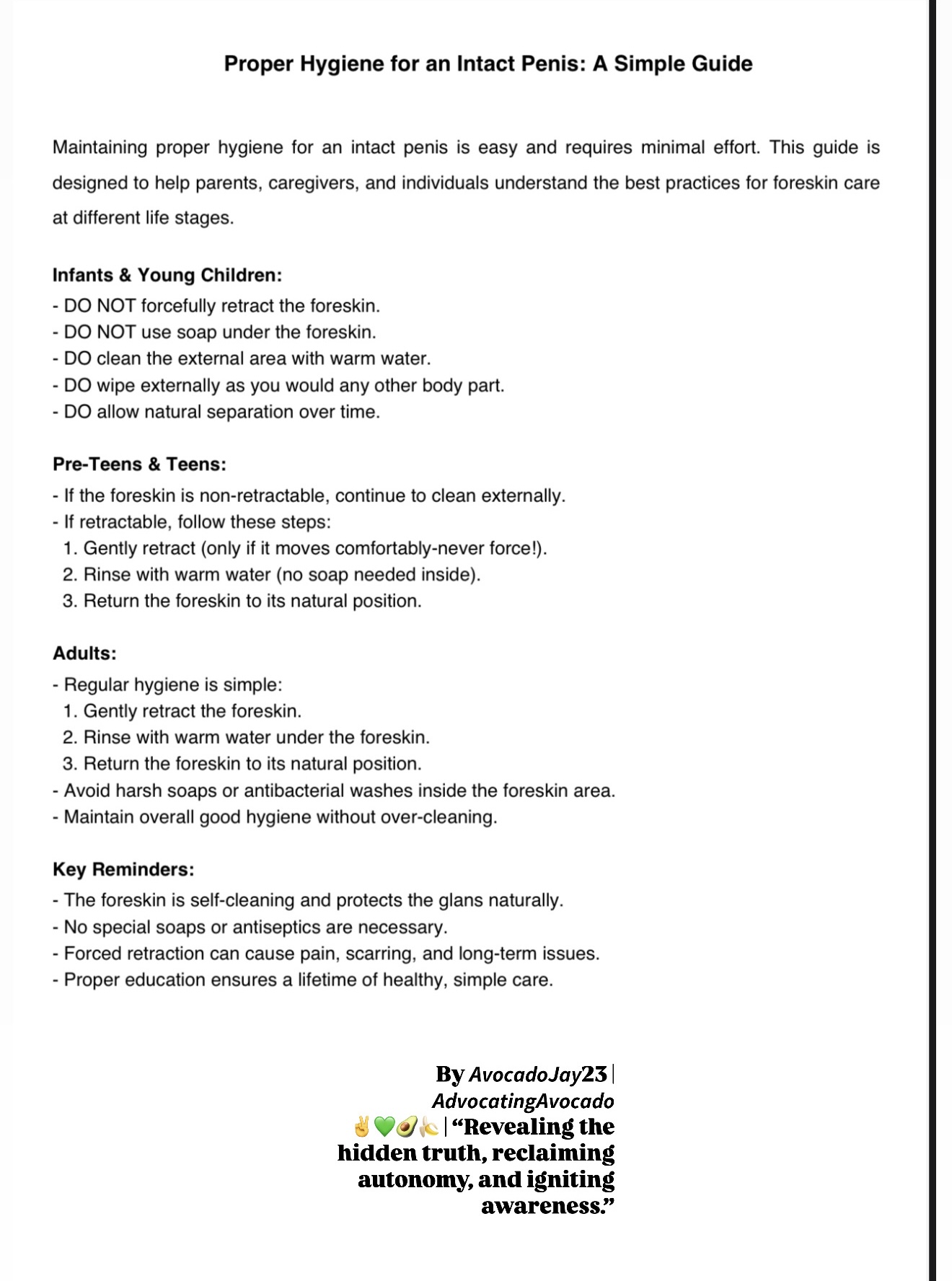Understanding the Male Foreskin: A Guide from Birth to Puberty
Understanding the Male Foreskin: A Guide from Birth to Puberty
The Cleaner Choice: Why an Intact Penis is Easier to Maintain Than a Circumcised One
Written By ✌️💚🥑🍌 AvocadoJay23 | AdvocatingAvocado
The Hygiene Myth: Why an Intact Penis is Easier to Care for Than a Cut One
The male foreskin is one of the most misunderstood parts of the human body, largely due to cultural misconceptions and misinformation. This misunderstanding is particularly prevalent in the United States, where mass circumcision is common. In contrast, the majority of the rest of the world remains intact and understands the natural function and purpose of the foreskin. Understanding its natural development, function, and care can help parents, caregivers, and young men make informed decisions regarding genital health.
The Natural Development of the Foreskin
When a baby boy is born, his foreskin is fused to the glans (head) of the penis. This natural adhesion serves multiple protective functions, including shielding the sensitive glans from friction, contaminants, and bacteria. Over time, as a child grows, the foreskin gradually separates from the glans. This process, known as desquamation, happens at varying rates and may take many years—often continuing until puberty or even later. It is crucial to understand that the foreskin does not need to be forcibly retracted at any point during childhood.
The Dangers of Forced Retraction
One of the most harmful misconceptions is that a baby’s foreskin must be retracted for cleaning. This is entirely false and can cause serious damage, including pain, bleeding, scarring, and even long-term issues like adhesions or acquired phimosis. The foreskin should be left alone and will naturally separate when the child’s body is ready. Pediatricians, parents, and caregivers must be educated to prevent forced retraction and unnecessary trauma.
Proper Hygiene: Less Is More
A common myth suggests that the intact penis requires special cleaning or is difficult to maintain. The truth is quite the opposite. In infancy and childhood, the foreskin should simply be wiped externally, just like any other part of the body, using only warm water. Soaps, especially those containing harsh chemicals or fragrances, should never be used under the foreskin as they can cause irritation and disrupt the natural balance of healthy bacteria.
Puberty and Natural Retraction
As boys enter puberty, the foreskin will gradually become retractable. This process is different for everyone, with some experiencing full retraction early in puberty and others later. Once the foreskin naturally retracts, a simple hygiene routine can be followed:
- Gently retract the foreskin (only if it moves comfortably).
- Rinse with warm water. There is no need for soap inside the foreskin as the body naturally maintains a healthy balance.
- Return the foreskin to its natural position. This prevents drying or irritation.
This routine is quick, easy, and helps maintain a clean, healthy genital area without unnecessary interference.
Why Keeping Boys Intact Is Simpler and Healthier
Despite widespread myths, caring for an intact male is far easier than managing a circumcised one. In contrast, circumcision requires a healing process, constant wound care, and the risk of complications such as infections, meatal stenosis (narrowing of the urinary opening), and lifelong loss of sensitivity. Additionally, circumcision can lead to other long-term complications that may not become apparent until later in life, such as erectile dysfunction, painful erections, keratinization of the glans (which reduces sensitivity), and psychological distress related to the loss of a functional body part. Many men also report feelings of anger or resentment upon learning the full extent of what was removed and the role the foreskin plays in sexual health and pleasure.
An intact penis functions exactly as nature intended—providing protection, moisture, and sensitivity while requiring minimal maintenance. Understanding this allows parents and young men to make empowered decisions about their health.
By spreading awareness about proper foreskin care and debunking misconceptions, we can help ensure that future generations grow up with healthy, intact bodies free from unnecessary interventions and misinformation. Education is the key to protecting bodily autonomy and promoting natural, uncomplicated genital health.
Additional Information and Resources
Frequently Asked Questions (FAQs)
Q: Is it normal for my child’s foreskin not to retract?
A: Yes! The foreskin remains fused to the glans in infancy and typically separates on its own over time. Retraction can occur naturally anytime between childhood and puberty.
Q: How should I clean my child’s intact penis?
A: Only warm water is needed. Simply wipe externally during diaper changes or baths. Never attempt to retract the foreskin.
Q: My child’s doctor suggested retraction for cleaning. Should I allow this?
A: No. Forced retraction can cause serious harm and is unnecessary. If your doctor is unaware of proper intact care, consider seeking a second opinion.
Medical and Scientific Insights
The foreskin is not a redundant piece of skin—it serves essential biological functions, including:
- Protection: The foreskin keeps the glans covered and protected from irritation and contamination.
- Moisturization: It helps retain natural moisture, preventing dryness and keratinization.
- Sensory Function: Packed with thousands of nerve endings, it plays a key role in pleasurable sensation.
- Gliding Mechanism: The foreskin facilitates smooth movement during sexual activity, reducing friction and discomfort.
Global Perspective on Circumcision
While routine infant circumcision is common in the United States, the majority of the world remains intact. Countries such as Japan, Sweden, Germany, and the UK do not practice mass circumcision and view it as unnecessary unless medically indicated. Studies show no significant health benefits to circumcision that justify it as a routine procedure.
Myth vs. Fact: Debunking Common Misconceptions
| MythFact | |
| Circumcision improves hygiene | An intact penis is easy to clean with simple rinsing. |
| Foreskin increases infection risk | There is no evidence that an intact foreskin leads to higher infection rates when proper hygiene is followed. |
| Circumcision prevents STDs | Safe sexual practices and condoms are far more effective in reducing STDs than circumcision. |
Printable Hygiene Guide
For a simple, one-page reference, download our printable hygiene guide, which includes clear instructions for parents and young men on proper foreskin care. Ensuring informed, gentle care is key to promoting long-term health and comfort.
-𝑨𝒗𝒐𝒄𝒂𝒅𝒐𝑱𝒂𝒚𝟐𝟑 ✌️💚🥑
“Uncut & Unapologetic.”
-𝑨𝒗𝒐𝒄𝒂𝒅𝒐𝑱𝒂𝒚𝟐𝟑 ✌️💚🥑
Foreskin is for Life, Not for Cutting.
“Protecting Natural Integrity: Understanding the Male Foreskin from Birth to Puberty”
#ForeskinFacts #IntactEducation #ProtectTheForeskin #SayNoToForcedRetraction #GenitalAutonomy #HealthyIntactBoys #ForeskinIsNormal #CircumcisionHarms #IntactAndProud #EducateBeforeYouCut #MaleGenitalIntegrity #EndRoutineCircumcision #ForeskinAwareness #LeaveItAlone #ForeskinHealth

Printable Hygiene Guide for Intact Foreskin Care
Proper Hygiene for an Intact Penis: A Simple Guide
Maintaining proper hygiene for an intact penis is easy and requires minimal effort. This guide is designed to help parents, caregivers, and individuals understand the best practices for foreskin care at different life stages.
For Infants & Young Children:
- DO NOT forcefully retract the foreskin.
- DO NOT use soap under the foreskin.
- DO clean the external area with warm water during baths.
- DO wipe externally as you would any other body part.
- DO allow natural separation to happen over time.
For Pre-Teens & Teens:
- If the foreskin is still non-retractable, continue to clean externally.
- If it becomes retractable, follow these simple steps:
- Gently retract (only if it moves comfortably—never force!).
- Rinse with warm water (no soap needed inside).
- Return the foreskin to its natural position to prevent dryness or discomfort.
For Adults:
- Regular hygiene is simple:
- Gently retract the foreskin.
- Rinse with warm water under the foreskin.
- Return the foreskin to its natural position.
- Avoid harsh soaps or antibacterial washes inside the foreskin area.
- Maintain overall good hygiene, but do not over-clean as this may cause irritation.
Key Reminders:
✔ The foreskin is self-cleaning and protects the glans naturally.
✔ No special soaps or antiseptics are necessary.
✔ Forced retraction can cause pain, scarring, and long-term issues.
✔ Proper education ensures a lifetime of healthy, simple care.
By following these easy steps, foreskin hygiene remains effortless, natural, and healthy!



Alternative Slogans for the Guide:
1. “Intact and Informed: A Complete Guide to Foreskin Care”
2. “Understanding Foreskin: Natural, Simple, Healthy”
3. “Gentle Care for a Natural Body: The Foreskin Guide”
4. “Protect, Educate, Preserve: The Truth About Foreskin”
5. “Healthy Boys, Intact Knowledge: A Guide to Proper Care”

Revised:
⸻
Understanding the Male Foreskin: A Guide from Birth to Puberty
The Hygiene Myth: Why an Intact Penis is Easier to Care for Than a Cut One
✍️ Written By: AvocadoJay23 | AdvocatingAvocado
Introduction: The Misunderstood Foreskin
The Hygiene Myth: Why an Intact Penis is Easier to Care for Than a Cut One
The male foreskin is one of the most misunderstood parts of the human body, particularly in cultures where circumcision is common. In the United States, misinformation has led many parents and caregivers to make decisions without fully understanding the foreskin’s natural development, function, and care.
Globally, the vast majority of men remain intact, and circumcision is generally considered unnecessary. This guide provides accurate, medically supported information on the foreskin’s development from birth through puberty, emphasizing proper care and the dangers of forced retraction.
⸻
🌱 The Natural Development of the Foreskin
Foreskin at Birth: A Protective Mechanism
At birth, the foreskin is naturally fused to the glans (head of the penis) by a membrane called the synechia—similar to how fingernails are attached to the nail bed.[¹] This serves several biological functions:
✔ Protection: Shields the glans from friction, bacteria, and contaminants.
✔ Moisturization: Keeps the glans soft and hydrated.
✔ Immune Defense: Contains specialized cells that fight infections.[²]
⸻
Natural Separation & Retraction: A Gradual Process
Retraction is a natural process that happens gradually over time. As a child grows, the synechia slowly dissolves, allowing the foreskin to separate from the glans.
📌 Key Facts About Retraction:
• It happens at different ages for every boy—sometimes not until puberty (or even later).
• Studies show that only 50% of boys can retract their foreskin by age 10, and some not until age 17+.[³]
• Forcibly retracting the foreskin before it naturally separates can cause pain, scarring, and adhesions.
⛔ WARNING: NEVER forcefully retract a child’s foreskin!
⸻
🚨 The Dangers of Forced Retraction
One of the most harmful misconceptions is that a baby’s foreskin must be retracted for cleaning. This is FALSE and can cause serious damage, pain, and complications.
🔴 Dangers of Forced Retraction:
• Tearing & Scarring – Causes painful adhesions and possible permanent damage.
• Bleeding & Infection – Can expose raw tissue to bacteria, increasing infection risk.
• Acquired Phimosis – Scarring can prevent normal retraction in adulthood.
📢 Parents and healthcare providers MUST be educated to prevent unnecessary harm to intact children. If a doctor recommends forced retraction, seek a second opinion!
⸻
🧼 Proper Hygiene: Less Is More
A common myth suggests that the intact penis requires special cleaning—this is completely false. Foreskin care is simple and requires minimal effort.
Hygiene for Infants & Young Children
✅ DO NOT retract the foreskin.
✅ DO NOT use soap under the foreskin.
✅ DO wipe externally with warm water during baths.
🚫 NO antiseptics, baby wipes, or special creams are needed.
⸻
Hygiene for Teens & Adults
Once the foreskin becomes naturally retractable, proper hygiene is simple:
1️⃣ Gently retract (only if it moves comfortably—never force!).
2️⃣ Rinse with warm water. (Soap is NOT needed inside.)
3️⃣ Return the foreskin to its natural position to prevent dryness.
🚨 Avoid harsh soaps, antibacterial washes, or aggressive cleaning. These can cause irritation and disrupt the natural balance of healthy bacteria.[⁴]
⸻
⚖️ Why Keeping Boys Intact Is Simpler & Healthier
Despite persistent myths, caring for an intact boy is easier than managing a circumcised one.
Circumcision Requires More Care & Comes with Risks
A circumcised baby requires:
🔹 Wound care for 7–10 days (risking infections & complications).
🔹 Petroleum jelly or special ointments to prevent painful adhesions.
🔹 Pain management due to exposed nerve endings.
📌 Circumcision can also lead to long-term complications, including:
• Meatal stenosis (narrowing of the urinary opening, affecting 10%+ of circumcised boys).[⁵]
• Loss of sensitivity due to keratinization of the glans.[⁶]
• Psychological distress in men who later regret being circumcised.[⁷]
An Intact Penis Functions as Nature Intended
✔ Self-cleaning – The foreskin naturally maintains moisture & balance.
✔ Protects the glans – Prevents desensitization and dryness.
✔ Enhances sexual function – Contains thousands of nerve endings for pleasure.[⁸]
💡 Keeping boys intact is the natural, low-maintenance choice!
⸻
🌍 Global Perspective on Circumcision
Most of the world does NOT practice routine infant circumcision. Countries like Japan, Sweden, Germany, and the UK only perform circumcision for medical necessity.
📊 Circumcision Rates by Region:
• United States: ~58% (dropping yearly)[⁹]
• Canada: ~31%
• UK, Germany, Japan, Sweden, Norway: <5%
🔎 Medical associations worldwide do NOT recommend routine circumcision. The procedure remains a cultural and profit-driven practice rather than a medical necessity.
⸻
🔍 Myth vs. Fact: Debunking Common Misconceptions
| Myth | Fact |
| Circumcision improves hygiene | Intact penis is easy to clean with simple rinsing. |
| Foreskin increases infection risk | No evidence supports this when proper hygiene is followed.[¹â°] |
| Circumcision prevents STDs | Safe sex practices & condoms are far more effective.[¹¹] |
⸻
📥 Downloadable Hygiene Guide
For a simple, one-page printable hygiene guide, download below:
📄 Download Foreskin Hygiene Guide (PDF)
⸻
📚 Additional Resources & Medical References
[1] Cold CJ, Taylor JR. The Prepuce. BJU Int. 1999.
[2] Fleiss PM, Hodges FM, Van Howe RS. Immunological Functions of the Human Prepuce. 2005.
[3] Øster J. Further Fate of the Foreskin. Arch Dis Child. 1968.
[4] Goldman R. The Psychological Impact of Circumcision. J Health Psychol. 1997.
[5] Van Howe RS. Incidence of Meatal Stenosis Following Neonatal Circumcision. Clin Pediatr. 2006.
[6] Sorrells ML et al. Fine-Touch Pressure Thresholds in the Adult Penis. BJU Int. 2007.
⸻
Final Thoughts: Protecting Natural Integrity
Education is the key to protecting bodily autonomy and ensuring boys grow up with healthy, intact bodies free from unnecessary interventions.
Foreskin is for life, not for cutting. 🚀
📢 Spread the word! #ForeskinFacts #GenitalAutonomy #EducateBeforeYouCut
———————————————-
📢 Want to Know the Truth?
👉 Watch Now: The Truth About Circumcision
Eric Clopper’s explosive, eye-opening presentation exposes the hidden truths about circumcision, its impact on men’s health, and the medical industry’s role in promoting it. If you care about bodily autonomy and human rights, this is a must-watch.
🔗 Sex & Circumcision: An American Love Story – Eric Clopper
🔗 https://youtu.be/FCuy163srRc?si=-I0uSf9MEV06bvY9

Comments
Post a Comment